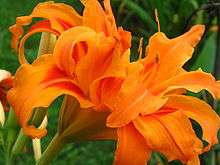Hemerocallis fulva
| Hemerocallis fulva | |
|---|---|
 | |
| Flower of Hemerocallis fulva var. fulva | |
| Scientific classification | |
| Kingdom: | Plantae |
| Clade: | Angiosperms |
| Clade: | Monocots |
| Order: | Asparagales |
| Family: | Asphodelaceae |
| Subfamily: | Hemerocallidoideae |
| Genus: | Hemerocallis |
| Species: | H. fulva |
| Binomial name | |
| Hemerocallis fulva (L.) L. | |
| Synonyms | |
| |
Hemerocallis fulva, the orange day-lily,[1] tawny daylily, tiger daylily, fulvous daylily or ditch lily (also railroad daylily, roadside daylily, outhouse lily, and wash-house lily), is a species of daylily native to Asia. It is very widely grown as an ornamental plant in temperate climates for its showy flowers and ease of cultivation. It is not a true lily in the genus Lilium, but gets its name from the similarity of the flowers and from the fact that each flower lasts only one day. It is occasionally mistaken for the unrelated true lily known as the "tiger lily", Lilium lancifolium, which is different in growth habit, floral construction and coloration.
Biology
It is an herbaceous perennial plant growing from tuberous roots, with stems 40–150 cm (16–59 in) tall. The leaves are linear, 50–90 cm (20–35 in) long and 1–2.8 cm (0.39–1.10 in) broad. The flowers are 5–12 cm (2.0–4.7 in) across, orange-red, with a pale central line on each tepal; they are produced from early summer through late autumn on scapes of ten through twenty flowers, with the individual flowers' opening successively, each one only lasting one day. The fruit is a three-valved capsule 2–2.5 cm (0.79–0.98 in) long and 1.2–1.5 cm (0.47–0.59 in) broad which splits open at maturity to release the seeds.[2][3]
Both diploid and triploid forms are known in the wild, but most cultivated plants are tetraploids which easily produce seeds and can also reproduce vegetatively by stolons or division. At least four botanical varieties are recognized, including the typical triploid var. fulva, the diploid, long-flowered var. angustifolia (syn.: var. longituba), the triploid var. kwanzo, where the stamens are modified into additional petals, and the evergreen var. aurantiaca.[2]
Distribution
Orange daylily is native to Asia from the Caucasus east through the Himalaya to China, Japan, and Korea.[2][3][4][5] Orange daylily persists where planted, making them a very good garden plant.
Hemerocallis fulva var. fulva has escaped from cultivation across much of the United States and parts of Canada and has become a weedy or invasive species.[6] It persists also where dumped and spreads more or less rapidly by vegetative increase into woods and fields and along roadsides and ditches, hence the common name ditch lily. It forms dense stands that exclude native vegetation, and is often so common that it is mistaken for a native species.

References
- ↑ "BSBI List 2007". Botanical Society of Britain and Ireland. Archived from the original (xls) on 2015-01-25. Retrieved 2014-10-17.
- 1 2 3 Flora of China: Hemerocallis fulva
- 1 2 Huxley, A., ed. (1992). New RHS Dictionary of Gardening. Macmillan ISBN 0-333-47494-5.
- ↑ Germplasm Resources Information Network: Hemerocallis fulva
- ↑ S.K. Czerepanov. Vascular Plants of Russia and Adjacent States (2007)
- ↑ USDA Plants Profile for Hemerocallis fulva (orange daylily)(Classified as invasive only by Wisconsin)
External links
 Data related to Hemerocallis fulva at Wikispecies
Data related to Hemerocallis fulva at Wikispecies Media related to Hemerocallis fulva at Wikimedia Commons
Media related to Hemerocallis fulva at Wikimedia Commons